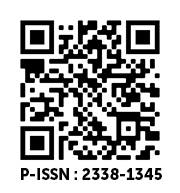Chitosan and Drying Temperature Optimization on the Quality of Bage Lemuru Fish using RSM Methods
DOI:
https://doi.org/10.36782/apjsafe.v11i1.167Keywords:
bage fish, chitosan, RSM optimization, sardinella lemuru, temperatureAbstract
Bage is a traditional fermented fish in Sumbawa made from lemuru fish (Sardinella lemuru). The aims of this study were to determine the chemical properties (moisture content and crude protein), microbial properties, and the panellist’s preferences for bage fish products after the addition of chitosan during the process. Optimization analysis using Response Surface Methodology showed that the temperature acquired was 60.93˚C. The chitosan concentration amounted to 3.51%, resulting in a water content of 23.47% and protein content of 49.91%. The number of microbial colonies in all treatments did not exceed the maximum limit of salted fish category product, based on SNI 8273 – 2016, but the fungal growth was found in samples with a temperature of 53 and 55˚C on the 20th day. The highest level of panellist preference for taste and aroma of bage fish was at a treatment temperature of 60 ° C with the addition of chitosan 4.62%, whereas the best texture was obtained by treatment at a temperature of 53˚C with the addition of 4.62% chitosan
Downloads
References
Grace, N.D. 2016. Effect of Drying and Seasoning Method on the Characteristics of Beef Jerky Milled Cob Fish. Thesis. Bandung: Faculty of Engineering, Pasundan University.
Arifin, Z., Nugroho, P. 2016. Application of Chitosan Shrimp Waste as a Preservative for Catfish. National Seminar, Yogyakarta: Samarinda State Polytechnic.
Association of Official Analytical Chemist. 2010. Official Methods of Analysis (18 Edn). USA: Association of Official Analytical Chemist Inc. Mayland.
Association of the Official Agricultural Chemists. 2010. Official Methods of Analysis. Washington DC.
Bell, C., Neaves, P., and Williams, A. P. 2005. Food Microbiology and Laboratory Practice. Blackwell Publishing. United Kingdom.
Box, G.E.P., and Draper, N.R. 2007. Response Surfaces, Mixtures, and Ridge Analyses. 2nd Edition. New Jersey: Jhon Wiley & Sons.
Cahyadi, W. 2009. Analysis &Health Aspects of Food Additives. Second Edition. Earth Script. Jakarta.
Central Bureau of Statistics. 2019. Sumbawa Regency in 2019 Figures. BPS Sumbawa Regency.
Central Bureau of Statistics. 2018. West Nusa Tenggra in Figures 2017. NTB: BPS West Nusa Tenggara Province.
Darmayanti, W., Rochima, E., and Hasan, Z. 2016. Application of Chitosan as Antibacterial On Patin Filet During Low Temperature Storage. Journal of Indonesian Fishery Products Processing, Vol. 19, No. 3, pp. 321-328.
Dompeipen, E. N. Kaimudin, M. and Dewa, R.P. (2016). Isolation of Chitin and Chitosan from Shrimp Skin Waste. BIAM Magazine. Vol. 12, No. 1, hal 32-38.
Elmoslemanya, A.M., Keefe, I.R. Dohoo, J.J. Witchel, H. Stryhn, and R.T. Dingwell. 2010. The Association Between Bulk Tank Milk Analysis For Raw Milk Quality And On-Farm Management Practices. Journal of Essentials of Food Microbiology. Prev Vet Med 95(1-2) pp 32-40.
Fellows, P.J. 2000. Food Processing Technology, Principle and Practice. 2nd edition. England: Woodhead Publishing Ltd.
Fraizer, 2000. Food Microbiology. New Delhi: Tata McGraw-Hill Publishing Company Limited.
Gafur, I.A., Wulandari, S., and Febrita, E. 2017. Effectiveness of Chitosan Addition in Improving the Quality Quality of Salted Mackerel (Rastrelliger sp) During Room Temperature Storage. Proceedings of the National Seminar. Medan: Medan State University.
Hardjito, L. 2006. Application of Chitosan as a Food Additive and Preservative. Proceedings of the Chitosan Chitin National Seminar. Faculty of Fisheries and Marine Sciences. Bogor Agricultural Institute.
Holipah, S., Wijayanti, E., and Saputra, V. 2010. Application of Chitosan as a Natural Preservative in Improving the Quality of Post-Harvest Product Storage. PKM Written Ideas. Bogor: Bogor Agricultural Institute.
Hui, Y. 2007. Food Drying Science and Technologies: Microbiology, Chemistry, Application. USA: Destech Publication.
Isnawati, N., Wahyuningsih, and Adlhani. 2015. Chitosan Making from Shrimp Shells (Penaeus merguinsis) and Its Application to Fresh Shrimp Preservatives. Journal of Agro-Industrial Technology. Vol. 2, No. 2, pp. 1-7
Jo, C., Lee, J.W., Lee, K.H., Byun, M.W. 2001. Quality Properties of Pork Sausage Prepared with Water-soluble Chitosan Oligomer. Meat Science 59 : 369-375.
Madina, H. 2018. Antioxidant Effect of Cayenne Pepper (Capsicum frutescens L) On Oxidative Stability of Sausage Products Physical Properties, Number of Bacteria and Organoleptic Quality. Thesis. Mataram: Faculty of Animal Husbandry, University of Mataram.
Meilgaard, M, Civille GV, and Carr BT. 2000. Sensory Evaluation Techniques. Boca Raton, Florida: CRC Press.
Nahardiansyah. 2018. Characterisics of Bage Lemuru Fish (Sardinella lemuru) Based on Temperature Differences and Drying Time Using the Oven. Thesis. Sumbawa: Sumbawa University of Technology.
Purnomo, H. 1995. Water Activity and Its Role in Food Preservatives. UI-Press. Jakarta.
Rachmawan, O. 2001. Drying, Cooling and Packaging of agricultural Commodities. Bulletin of the Ministry of National Education. Jakarta.
Riansyah, A., Supriadi, A., and Nopianti, R. 2013. Effect of Temperature Differences and Drying Time on the Characteristics of Siamese Sepat Salted Fish (Trichogaster Pectoralis) using an Oven. Fishtech Journal. Vol. 2, No. 1, pp. 53-68.
Sarwono, R. 2010. Utilization of Chitin / Chitosan as Antimicrobial Material. Journal of Chemistry Tewrapan Indonesia. Vol. 12, No. 1, pp. 32-38.
Sawaluddin, 2016. Examination of Mineral Levels of Magnesium, Potassium, and Calcium in Sardines (Sardinella lemuru) Canned and Fresh Packaging with atomic absorption spectrophotometry method. Thesis. Medan: Faculty of Pharmacy, University of North Sumatra.
Sukmawati. 2018. Total Microbial Plate on Beef and Beef Offial. Bioscience, 2 (1), 22-28.
Sedjati, S. and Agustini, W.T. 2007. The Effect of Chitosan Concentration and Storage Time on The Quality of Salted-Dried Anchovy (Stolephorus heterolobus). Journal of Coasial Development. 10(2): 63-71.
Sitindaon, J. 2007. Physical and Organoleptic Properties of Buffalo Meat Frankfurters Sausage (Bubalus bubalis) with the Addition of Khitosan Instead of Sodium Trypolyphospate. Faculty of Animal Husbandry. IPB. Bogor.
Indonesian National Standards, 2016. Dried Salted Fish. National Standardization Agency.SNI:8237-1:2009. Jakarta.
Tarwendah, I.P. 2017. Comparative Study of Sensory Attributes and Brand Awareness of Food Products. Journal of Food and Agroindustry. Vol. 5, No. 2, p. 2. 66-73.
Winarno. 2002. Food Science and Nutrition. PT. Gramedia Main Library. Jakarta.
Wittriansyah, K. Soedihono, and Satriawan D. 2019. Application Chitosan Emerita sp. As an Alternative Preservative in Mullet Fish (Mugil cephalus). Scientific Journal of Fisheries and Marine Affairs. Vol. 11, No. 1, p. 1. 34-42.
Yuniarti, D.W. Sulistiyati, T.D. Suprayitno, E. 2013. Effect of Vacuum Drying Temperature on Powder Quality Snakehead Fish Albumin (Ophiocephalus striatus). THP Student Journal. Vol. 1, No.1, pp. 1-11.
Yuarni, D. Kadirman, and Jamaludin. 2015. Rate of Change in Moisture Content, Protein Content, and Organoleptic Test of Salted Catfish Using a Cabinet Dryer with Controlled Temperature. Journal of Agricultural Technology. Vol. 1, No. 1, pp. 12-21.









